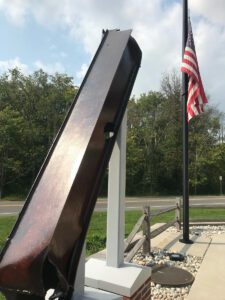 As we mark the 20th anniversary of the 9/11 attacks, we are reminded of what it means to live in America. Nearly 30 Mercer County residents were amongst the 2,977 who perished that day as terrorists sought to challenge the freedoms of American life. While they took mothers, fathers, brothers, sisters, daughters, sons and dear friends – they could not take away the American spirit or the desire from those abroad to live the American dream here.
As we mark the 20th anniversary of the 9/11 attacks, we are reminded of what it means to live in America. Nearly 30 Mercer County residents were amongst the 2,977 who perished that day as terrorists sought to challenge the freedoms of American life. While they took mothers, fathers, brothers, sisters, daughters, sons and dear friends – they could not take away the American spirit or the desire from those abroad to live the American dream here.
In fact, in the weeks, and years since that fateful day, numerous families from war-torn countries have sought refuge in the United States, with Afghan and Iraqi refugees settling in places like Princeton, Lawrenceville, Hamilton and Montgomery. Today, 20 years after the attacks, our country is once again helping Afghan refugees. Interfaith-RISE (I-RISE), a Highland Park-based affiliate agency of USCRI (US Committee for Refugees and Immigrants) works with local assistance from the Princeton chapter of I-RISE and The Jewish Center’s Interfaith Refugee Resettlement Committee (TJC/IRRC) to assist and relocate families. Earlier this year I-RISE brought 47 Afghans to central New Jersey with another 125 of them making this area home after the recent US withdrawal.
“USCRI has the direct lines to the State Department and UNHCR (United Nations High Commissioner for Refugees), and we provide on-the-ground support for these families when they first arrive,” explains Louise Sandberg, Coordinator of TJC/IRRC. “Our Committee has worked with families and individuals from Afghanistan, Iraq, Burma, Pakistan, Eritrea, Cameroon, Saint John, Guatemala, El Salvador, Tibet, Syria and Turkey.”
The refugees that have sought to resettle in Princeton came here because they have a friend or family that has offered support or because the committee was able to find affordable housing to assist them. Coming to the Princeton-area, they join a growing international population.
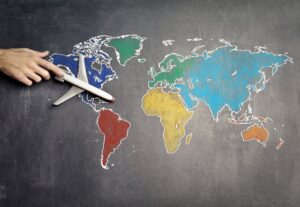 While there is no exact data available to detail how many nationalities are represented amongst the Princeton population, 2019 Census statistics indicate 28.5% of those living in Princeton, NJ are foreign-born – including 43% from Asia, 30% from Europe and 19% from Latin America. Some come here seeking refuge and assistance, and others come here to join family, follow opportunities in their profession or to advance their education.
While there is no exact data available to detail how many nationalities are represented amongst the Princeton population, 2019 Census statistics indicate 28.5% of those living in Princeton, NJ are foreign-born – including 43% from Asia, 30% from Europe and 19% from Latin America. Some come here seeking refuge and assistance, and others come here to join family, follow opportunities in their profession or to advance their education.
Having internationally prestigious institutions like Princeton University (PU) and the Institute for Advanced Study (IAS) plays a large role in attracting an international population to town.
Of the 271 visiting scholars at IAS this year, 124 of them are international and hail from 37 foreign countries including Argentina, Australia, Austria, Bangladesh, Belgium, Brazil, Canada, China, Croatia, Czech Republic, Ecuador, France, Germany, Greece, Hungary, Iceland, India, Iran, Israel, Italy, Japan, Kazakhstan, Korea, Malaysia, the Netherlands, Nigeria, Poland, Portugal, Russia, Spain, Sweden, Switzerland, Taiwan, Turkey, United Arab Emirates, United Kingdom and Vietnam.
Students from 58 countries (representing 13% of the incoming class) came to Princeton when PU welcomed its newly enrolled freshman 2 weeks ago. The students are citizens of countries including Albania, China, Colombia, Egypt, Indonesia, the Netherlands and Rwanda. At the graduate level, the 713 incoming students hail from 54 different countries. Due to COVID hampering the arrival of many international students last year, the last compiled data of the entire PU population from its 2019-2020 school year shows 2,053 international students were enrolled. A combination of undergraduate and graduate students (at a 1:2 ratio), those students vastly increase the international population of Princeton. Most of the students that came from other countries to study at PU are from China, Canada, India, United Kingdom, S. Korea, Germany, Australia, Turkey, Brazil, France, Italy, Russia, Mexico, Spain and Romania but there was also at least one student from each of 95 additional foreign countries, all represented in the map below:
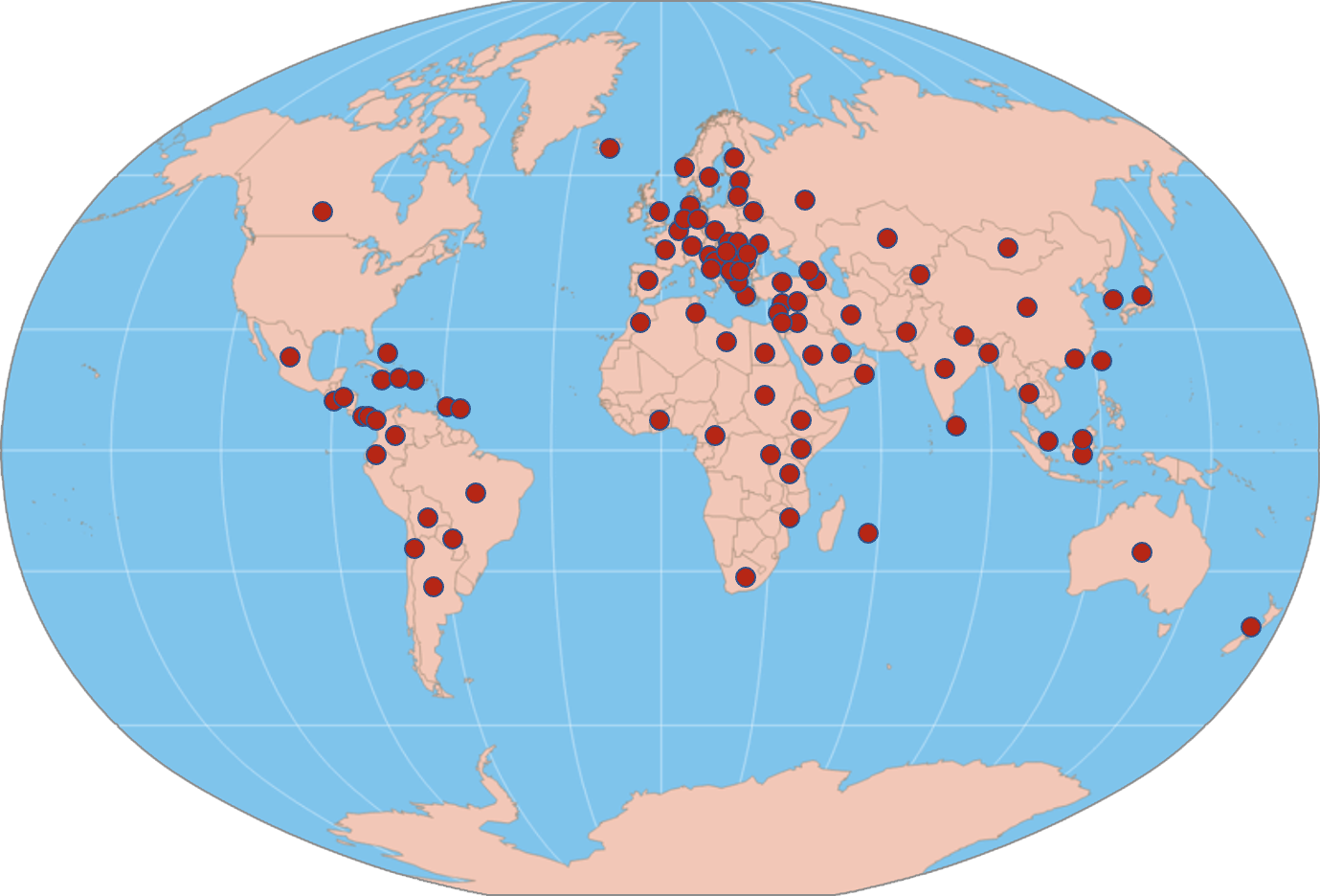
In addition to the international student body and faculty the local educational institutions entice to Princeton, pharmaceutical and other high-tech businesses also attract numerous professionals to Central Jersey from around the world.
“New Jersey is our corporate home, and we are proud to have more than 13,000 world-class employees in New Jersey working across our campuses,” shares a Bristol Myers Squibb company spokesperson. “Bringing innovative medicines to patients depends on a workforce with diverse experiences, perspectives and personal backgrounds that reflect the patients and communities we serve around the world.”
Of those coming either temporarily or permanently for education or job opportunities, some come alone to this area, but many bring along their families. The Princeton Public School (PPS) system has approximately 45 languages spoken amongst its student body today. Some of the students come with proficiency in English, but many others need support to learn in our English-based schools.
At each of the four elementary schools there is a fulltime English as a Second Language (ESL) teacher assisting 20-30 students who qualify for ESL services. Princeton Middle School has a specialist that co-teaches English with one of the English teachers, as well as separate ESL classes. There was also an aide hired last year to help the Spanish-speaking ESL students who need additional support for their science, math and social studies classes. In the past five years, Princeton High School has enhanced its program to meet the needs of its many Students with Limited or Interrupted Formal Education (SLIFE). The high school engages multiple ESL teachers and has several co-taught classes to help this largely Latino population.
“For the other half of our ESL kids who come from all over the world, we have support classes in English, language arts and writing workshop classes. We also give them support in math, science and social studies if they need it,” explains Priscilla Russel, PPS Supervisor for World Languages.
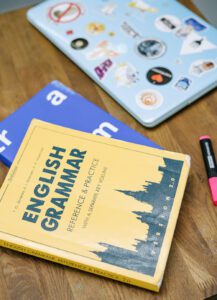 Many adults that come here also take ESL classes to learn or improve their English language skills. Princeton Adult School and YWCA Princeton offer several classes. PU also has a language program for its own students. To learn more about what ESL is and how people living here have benefitted from these programs you can read How Princeton Helps Adults Learn the English Language in this issue. To further practice the language, Princeton Public Library offers ESL conversation groups, currently online.
Many adults that come here also take ESL classes to learn or improve their English language skills. Princeton Adult School and YWCA Princeton offer several classes. PU also has a language program for its own students. To learn more about what ESL is and how people living here have benefitted from these programs you can read How Princeton Helps Adults Learn the English Language in this issue. To further practice the language, Princeton Public Library offers ESL conversation groups, currently online.
With a desire to improve their English, many of the people that come to Princeton from abroad are highly educated. More than 81% of the municipal population overall has a bachelor’s degree or higher (56% have post-grad education), according to the 2019 Census. Additionally, less than 8% of the total Princeton population lives below the poverty line. Some of those people are here from other countries, in need of assistance.
Of those it helps, the Princeton Department of Human Services estimates 65% are Hispanic (mostly from Guatemala and Mexico), 20% are Black (many from Haiti and Ghana), 10% are Asian (from China and India) and 5% are Caucasian.
In addition to providing information and referrals to community partners that offer ESL, citizenship and driving classes, Health & Human Services assists people when applying for programs like General Assistance, SNAP (food stamps), Women, Infants and Children (WIC) and the Well Baby Health Clinics as well as refers them to partners who provide meals and affordable housing.
The department occasionally serves refugees coming to this area, but they are most often assisted by organizations like I-RISE and TJC/IRRC. The incoming refugees are often in need of housing they can afford or that can be covered through community programs. If you have or know of residential locations that could fit this need, you can click here to contact Louise Sandberg.
Part of what makes Princeton so enticing to people from around the world is the municipality celebrates its diversity and strives to bring everyone together. One of the ways this is done is through Welcoming Week, which this year is being held until September 19th.
Welcoming Week Flyer – ADA Checked 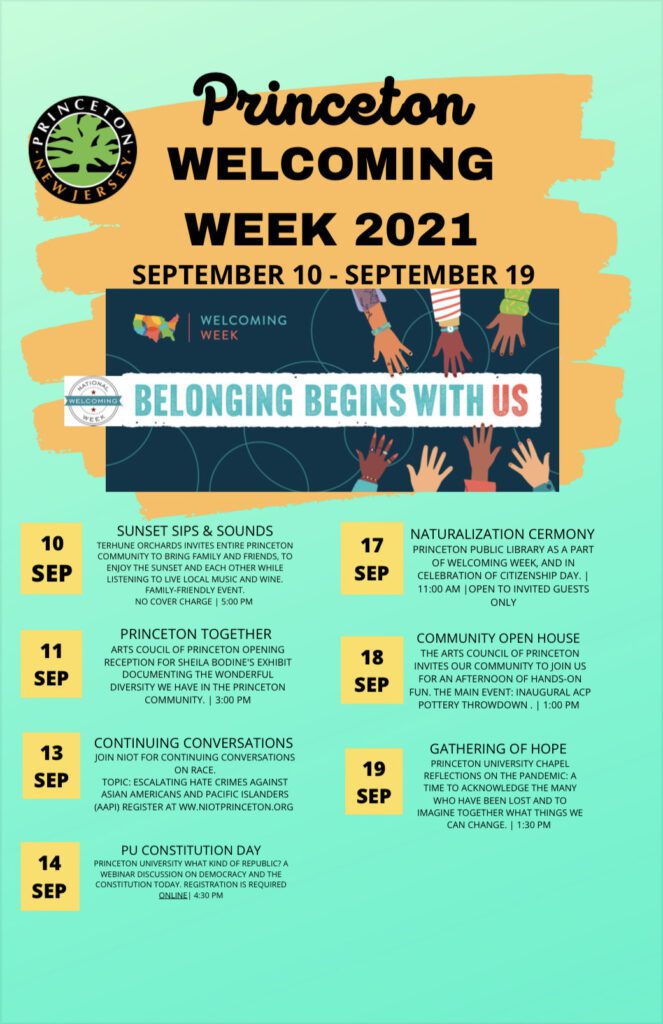 “During Welcoming Week, we join cities across the world to promote unity, diversity and inclusiveness to build strong connections and affirm the importance of community,” explains Veronica Olivares-Weber, Princeton Human Services Commission Chair. “Welcoming Week is a wonderful opportunity for us to come together as a community to affirm that Princeton is a place where we want to weave together all residents to be a part of the fabric of our shared future.”
“During Welcoming Week, we join cities across the world to promote unity, diversity and inclusiveness to build strong connections and affirm the importance of community,” explains Veronica Olivares-Weber, Princeton Human Services Commission Chair. “Welcoming Week is a wonderful opportunity for us to come together as a community to affirm that Princeton is a place where we want to weave together all residents to be a part of the fabric of our shared future.”
The internationality of this suburb also creates great opportunities to learn about other places and get exposed to tastes and traditions from a variety of cultures. These are a benefit whether you are new here or have lived here all of your life.
Many foreigners and immigrants have opened restaurants and experiences that offer a taste of their home country to Princeton. The flavors of China, India, Japan, Italy, Greece, France, Syria and so many other countries can be found in eateries across town. You can learn dances, shop for cultural mementos, enjoy international artwork and more at numerous locations. In fact, a sampling from every continent worldwide is available around the Princeton area and you can read more specifics from our April issue in You Don’t Have to Leave the Princeton Area to Experience the World.
Many come to the United States and retain their home citizenship, either as part of their identity, with a desire to return one day or because they are here only for a set amount of time. Others come and over time, decide this is where they want to stay and become a citizen. On Friday, September 17th, you can see the embodiment of what this means as the Princeton Public Library hosts a naturalization ceremony (closed to the public this year).
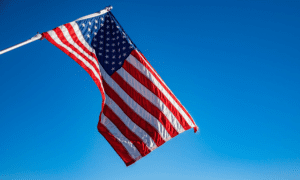 Though terrorists sought to destroy American freedoms on 9/11 twenty years ago, the way of life here is still something many seek out. As we honor the memories of those lost that fateful day, we can feel pride in the fact that the Princeton community has kept the American spirit going, inviting those from all over the world to make it their home.
Though terrorists sought to destroy American freedoms on 9/11 twenty years ago, the way of life here is still something many seek out. As we honor the memories of those lost that fateful day, we can feel pride in the fact that the Princeton community has kept the American spirit going, inviting those from all over the world to make it their home.
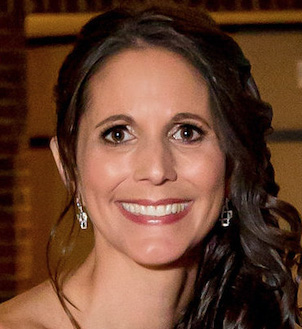
Lisa Jacknow spent years working in national and local news in and around New York City before moving to Princeton. Working as both a TV producer and news reporter, Lisa came to this area to focus on the local news of Mercer County at WZBN-TV. In recent years, she got immersed in the Princeton community by serving leadership roles at local schools in addition to volunteering for other local non-profits. In her free time, Lisa loves to spend time with her family, play tennis, sing and play the piano. A graduate of the S. I. Newhouse School of Public Communications at Syracuse University, Lisa was raised just north of Boston, Massachusetts but has lived in the tri-state area since college. She is excited to be Editor and head writer for Princeton Perspectives!

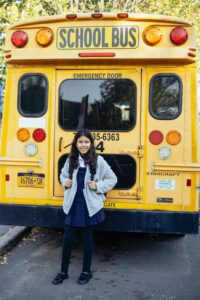 Studies have shown that bilingual education creates students with more empathy and cultural awareness, enhances one’s ability to think and process concepts and provides a wider range of opportunities. So why is it that most Americans speak predominantly just one language when throughout most of the world it is quite common to speak two or more? While most Americans will learn concepts of a second language through school, the latest census data (2019) shows that only 35% of Princetonians speak a language other than English at home. There is, however, an increased desire for children to start learning a second language at a younger age and ultimately become bilingual.
Studies have shown that bilingual education creates students with more empathy and cultural awareness, enhances one’s ability to think and process concepts and provides a wider range of opportunities. So why is it that most Americans speak predominantly just one language when throughout most of the world it is quite common to speak two or more? While most Americans will learn concepts of a second language through school, the latest census data (2019) shows that only 35% of Princetonians speak a language other than English at home. There is, however, an increased desire for children to start learning a second language at a younger age and ultimately become bilingual.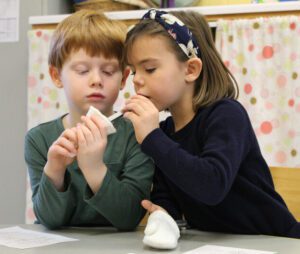 Corinne Gungor, a teacher from the
Corinne Gungor, a teacher from the 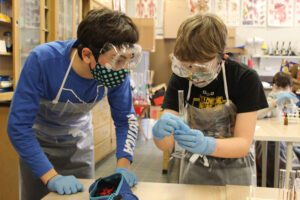 The 165+ students are a mix of expats who want the bilingual education and locals who believe in its benefits. 57% of the current student body are English-native speakers, 28% French-native speakers and 15% are speakers of another native tongue. They usually learn some classes in French, some in English and some a combination of both. Math and French are taught in both languages, Science and other STEM classes as well as music are taught in English and social studies, art and physical education often in French.
The 165+ students are a mix of expats who want the bilingual education and locals who believe in its benefits. 57% of the current student body are English-native speakers, 28% French-native speakers and 15% are speakers of another native tongue. They usually learn some classes in French, some in English and some a combination of both. Math and French are taught in both languages, Science and other STEM classes as well as music are taught in English and social studies, art and physical education often in French. What started as a weekend school, YHIS was created out of a desire for families that wanted more. It was founded as a formal private school in 2007 and has existed in various locations (including a church basement) leading up to its current building on Laurel Avenue on the border of Kingston. With 108 students enrolled this year in The Early Learning Program through 8th grade, it is now exceeding capacity at this space and is hoping to move somewhere larger within the next five years.
What started as a weekend school, YHIS was created out of a desire for families that wanted more. It was founded as a formal private school in 2007 and has existed in various locations (including a church basement) leading up to its current building on Laurel Avenue on the border of Kingston. With 108 students enrolled this year in The Early Learning Program through 8th grade, it is now exceeding capacity at this space and is hoping to move somewhere larger within the next five years.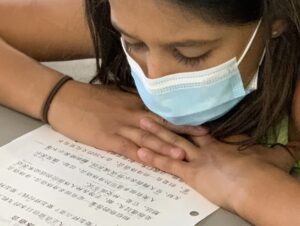 Like FASP, YHIS starts with intense immersion. 100% of instruction from preschool through Kindergarten is in Chinese. In first grade, lessons are 20% in English up to 25% in second grade, 35% in third grade and 45% in fourth. Middle school classes, grades 5-8, are taught in 50% Mandarin, 50% English. Classes are taught in one language or the other, not mixed, but the teachers collaborate on their lesson plans to create continuity between the classes.
Like FASP, YHIS starts with intense immersion. 100% of instruction from preschool through Kindergarten is in Chinese. In first grade, lessons are 20% in English up to 25% in second grade, 35% in third grade and 45% in fourth. Middle school classes, grades 5-8, are taught in 50% Mandarin, 50% English. Classes are taught in one language or the other, not mixed, but the teachers collaborate on their lesson plans to create continuity between the classes. Across town, what was once a neighborhood Princeton Public School (PPS) is now the newest dual language program in Princeton. Seven years ago,
Across town, what was once a neighborhood Princeton Public School (PPS) is now the newest dual language program in Princeton. Seven years ago, 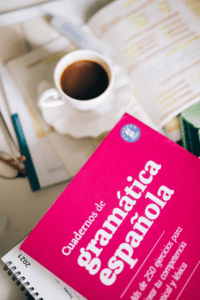 With the goal of developing communicative and cultural competence and confidence, the program expanded adding a grade each year as the students aged up. This year all Community Park students grade K-3 are in the immersion program, though there is still one 4th grade and two 5th grade traditional classes in the building. In two years, there will no longer be any cohorts but all grades at the school will be dual language.
With the goal of developing communicative and cultural competence and confidence, the program expanded adding a grade each year as the students aged up. This year all Community Park students grade K-3 are in the immersion program, though there is still one 4th grade and two 5th grade traditional classes in the building. In two years, there will no longer be any cohorts but all grades at the school will be dual language.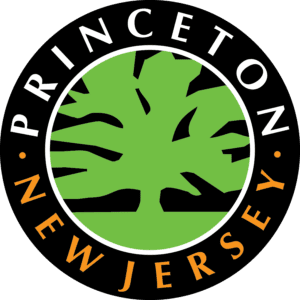 Most of us spent the summer getting out more and resuming some of the activities we’d avoided during the previous 18 months of the pandemic, thinking the worst was behind us. And while the high vaccination rates in Princeton should prevent severe illness or death for most, Princeton is starting to see a return of COVID infections. The Delta variant is assumed responsible for 90% of NJ’s COVID-19 infections over the past 3 weeks, a trend that is starting to appear in town as well. Should this become more severe, it could prompt the municipality to enact some changes. For now, mask mandates are only being required at K-12 schools (per the governor), yet the Princeton Health Department is advising people to resume wearing masks when indoors, especially if going home to unvaccinated people.
Most of us spent the summer getting out more and resuming some of the activities we’d avoided during the previous 18 months of the pandemic, thinking the worst was behind us. And while the high vaccination rates in Princeton should prevent severe illness or death for most, Princeton is starting to see a return of COVID infections. The Delta variant is assumed responsible for 90% of NJ’s COVID-19 infections over the past 3 weeks, a trend that is starting to appear in town as well. Should this become more severe, it could prompt the municipality to enact some changes. For now, mask mandates are only being required at K-12 schools (per the governor), yet the Princeton Health Department is advising people to resume wearing masks when indoors, especially if going home to unvaccinated people.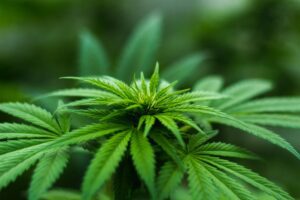 67% of New Jersey voters (and 71% of those in Mercer County) approved it last November and in February, NJ Governor Phil Murphy signed the legalization of cannabis (for those over 21) into law, but does that mean Princeton residents want to invite the cannabis industry to town? There are not yet any cannabis businesses within the boundaries of Princeton, and the town is taking time to do its due diligence before deciding whether to allow any.
67% of New Jersey voters (and 71% of those in Mercer County) approved it last November and in February, NJ Governor Phil Murphy signed the legalization of cannabis (for those over 21) into law, but does that mean Princeton residents want to invite the cannabis industry to town? There are not yet any cannabis businesses within the boundaries of Princeton, and the town is taking time to do its due diligence before deciding whether to allow any.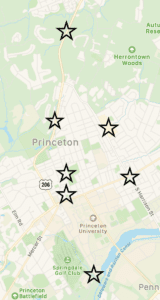 The 23-member Cannabis Task Force comprised of local officials, business members, town residents, representatives from Princeton Public Schools, the police, organizations and more has chosen to first look at retail licensing to determine what, if any, parameters should be created. So far, specific commercial zones have been identified within Princeton’s borders. These include 206 North (the Bottle King area), lower 206 North (corner of Mt. Lucas and Cherry Hill Roads), Witherspoon North (Witherspoon from Green Street to about Leigh Avenue), the Central business district (Palmer Square/downtown area), the Dinky area (where Metro North is), Jugtown Historic District (corner of Harrison and Nassau Streets) and Princeton Shopping Center. The Task Force is still considering if any or all of these zones should allow cannabis dispensaries.
The 23-member Cannabis Task Force comprised of local officials, business members, town residents, representatives from Princeton Public Schools, the police, organizations and more has chosen to first look at retail licensing to determine what, if any, parameters should be created. So far, specific commercial zones have been identified within Princeton’s borders. These include 206 North (the Bottle King area), lower 206 North (corner of Mt. Lucas and Cherry Hill Roads), Witherspoon North (Witherspoon from Green Street to about Leigh Avenue), the Central business district (Palmer Square/downtown area), the Dinky area (where Metro North is), Jugtown Historic District (corner of Harrison and Nassau Streets) and Princeton Shopping Center. The Task Force is still considering if any or all of these zones should allow cannabis dispensaries.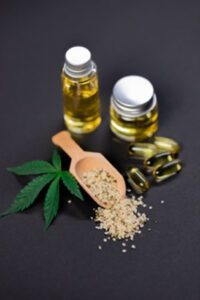 When it comes to retail, more than 60% of those polled do not want dispensaries in Princeton. There is a great fear of retail exposing it to kids. There is also a bit of “not in my town” mentality with people concerned about ease of access, who it will bring into our community and it being a gateway drug.
When it comes to retail, more than 60% of those polled do not want dispensaries in Princeton. There is a great fear of retail exposing it to kids. There is also a bit of “not in my town” mentality with people concerned about ease of access, who it will bring into our community and it being a gateway drug.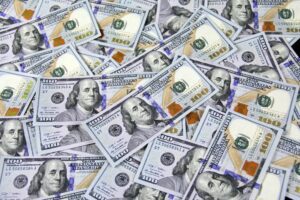 “There are other license classes that aren’t necessarily touching the plant and ancillary businesses that could bring in jobs,” Johnson noted. “There are distribution companies that have an interest in setting up in Princeton, it’s not all about dispensaries.”
“There are other license classes that aren’t necessarily touching the plant and ancillary businesses that could bring in jobs,” Johnson noted. “There are distribution companies that have an interest in setting up in Princeton, it’s not all about dispensaries.”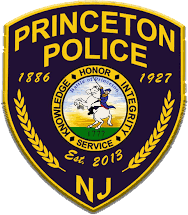 “The
“The 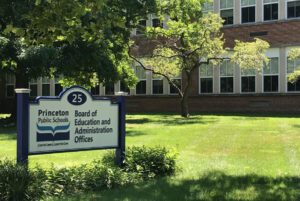 A new Health and Safety Referendum for PPS could be approved as early as January 2022, if that’s what Princeton voters want. At its July 27th meeting, the
A new Health and Safety Referendum for PPS could be approved as early as January 2022, if that’s what Princeton voters want. At its July 27th meeting, the  Through ongoing inventory of all school facilities and systems, PPS administration identified a list of repairs and replacements that are overdue or needed soon. The assessments found roofs at
Through ongoing inventory of all school facilities and systems, PPS administration identified a list of repairs and replacements that are overdue or needed soon. The assessments found roofs at 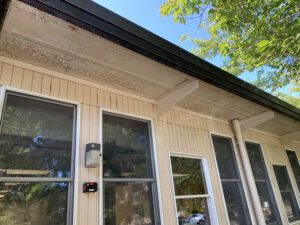 “The ongoing assessment and repair of our facilities is necessary as failing roofs and equipment need to be replaced,” said Matt Bouldin, Business Administrator for
“The ongoing assessment and repair of our facilities is necessary as failing roofs and equipment need to be replaced,” said Matt Bouldin, Business Administrator for 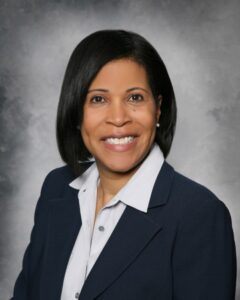 As of July 1, Dr. Carol Kelley began her tenure as the newly hired Superintendent for the district. Dr. Kelley had departed the Garden State to serve six years as superintendent for a district just outside of Chicago, Illinois, and is excited to be back in New Jersey to help move our children forward.
As of July 1, Dr. Carol Kelley began her tenure as the newly hired Superintendent for the district. Dr. Kelley had departed the Garden State to serve six years as superintendent for a district just outside of Chicago, Illinois, and is excited to be back in New Jersey to help move our children forward.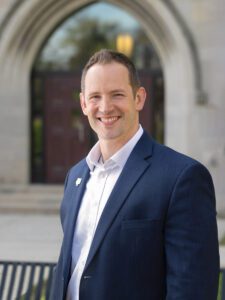 PHS Principal Jessica Baxter was in the role for just 18 months when she left in January, and Jared Warren then stepped up from his assistant principal role to finish out the year as acting principal. He has since left the district and PPS’s former Supervisor of Humanities (Gr. 7-12), Stephanie Greenberg, is moving into the assistant principal role he vacated. Leading the high school administration is now Frank Chmiel. A former
PHS Principal Jessica Baxter was in the role for just 18 months when she left in January, and Jared Warren then stepped up from his assistant principal role to finish out the year as acting principal. He has since left the district and PPS’s former Supervisor of Humanities (Gr. 7-12), Stephanie Greenberg, is moving into the assistant principal role he vacated. Leading the high school administration is now Frank Chmiel. A former 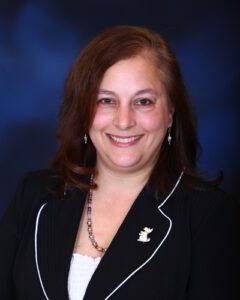 At the end of the last school year Director of Guidance, Health and Wellness Dr. Kristina Donovan informed the district she was leaving and PPS Administration has just completed the process of hiring her replacement. Dana Karas has worked in schools as a teacher and counselor for years, including at Princeton Public Schools as a middle school French teacher and high school counselor. Princeton’s new Director of Student Counseling Services held a guidance supervisory role in both Lawrence Township Public Schools and Franklin Township Public Schools. With this new hire, his other administrators, staff, students and their families, Chmiel promises he is looking to work together.
At the end of the last school year Director of Guidance, Health and Wellness Dr. Kristina Donovan informed the district she was leaving and PPS Administration has just completed the process of hiring her replacement. Dana Karas has worked in schools as a teacher and counselor for years, including at Princeton Public Schools as a middle school French teacher and high school counselor. Princeton’s new Director of Student Counseling Services held a guidance supervisory role in both Lawrence Township Public Schools and Franklin Township Public Schools. With this new hire, his other administrators, staff, students and their families, Chmiel promises he is looking to work together.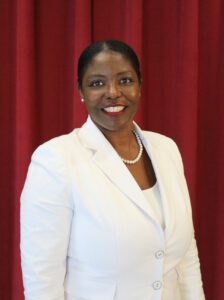 On August 23rd, Ebony Lattimer will take over as
On August 23rd, Ebony Lattimer will take over as 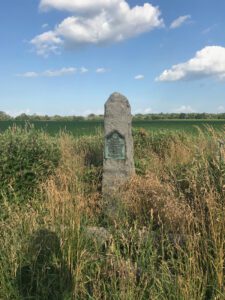 Princeton is a unique town in many ways. Built more like a small city, it has culture, shopping, restaurants, multiple world-renowned educational institutions and such a vast historic landscape. On nearly every corner you can find something to learn about Princeton’s past.
Princeton is a unique town in many ways. Built more like a small city, it has culture, shopping, restaurants, multiple world-renowned educational institutions and such a vast historic landscape. On nearly every corner you can find something to learn about Princeton’s past.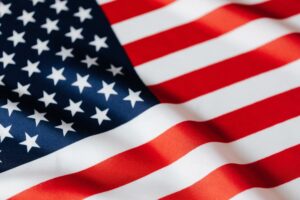 The week of July 4th, firework displays in Lawrenceville, Hamilton, and Mercer County Park entertained us locally. Chances are as you drove to your destination, you passed obelisks and monuments on the sides of the road that you’ve passed a thousand times, but never really took time to discover what historic events they commemorate. And as the fireworks burst in celebration of the independence of our United States, you were likely more focused on who you were with and who brought the desserts than on what took place in history to allow you to gather together at all.
The week of July 4th, firework displays in Lawrenceville, Hamilton, and Mercer County Park entertained us locally. Chances are as you drove to your destination, you passed obelisks and monuments on the sides of the road that you’ve passed a thousand times, but never really took time to discover what historic events they commemorate. And as the fireworks burst in celebration of the independence of our United States, you were likely more focused on who you were with and who brought the desserts than on what took place in history to allow you to gather together at all.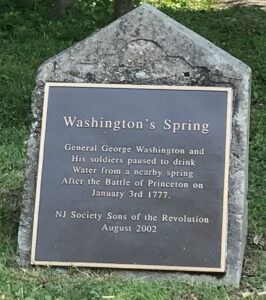 “Many towns and locations find an immense amount of pride in detailing the historic events which occurred in their town, county, etc. These can range from events of some historic importance (i.e., skirmishes, meetings, etc.) to the mundane (Washington’s spring outside of the battlefield – Washington’s troops stopped to drink here). These markers commemorate historic moments no matter how small,” explains Will Krakower, Resource Interpretive Specialist for The New Jersey Department of Environmental Protection, Division of Parks and Forestry. “The ground we walk every day, every walk in the park, every stroll down Nassau, every drive to work, rests on ground which our ancestors walked, and in some cases fought and died, for their right to live a good life – a free life.”
“Many towns and locations find an immense amount of pride in detailing the historic events which occurred in their town, county, etc. These can range from events of some historic importance (i.e., skirmishes, meetings, etc.) to the mundane (Washington’s spring outside of the battlefield – Washington’s troops stopped to drink here). These markers commemorate historic moments no matter how small,” explains Will Krakower, Resource Interpretive Specialist for The New Jersey Department of Environmental Protection, Division of Parks and Forestry. “The ground we walk every day, every walk in the park, every stroll down Nassau, every drive to work, rests on ground which our ancestors walked, and in some cases fought and died, for their right to live a good life – a free life.”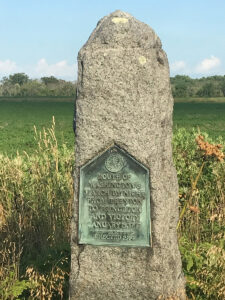 To mark this freedom and the 18-mile route the troops took to the Princeton Battlefield from Trenton, obelisks were placed in 1914 by the Sons of the Revolution. They used a collection of diaries, including that of Anderson’s, to map out the approximate route.
To mark this freedom and the 18-mile route the troops took to the Princeton Battlefield from Trenton, obelisks were placed in 1914 by the Sons of the Revolution. They used a collection of diaries, including that of Anderson’s, to map out the approximate route.
 In fact, Williams contends the obelisk at Quakerbridge Road and Nassau Park Boulevard was placed on the median rather than in the middle of what was then an adjacent farm field, where the troops actually marched, to ensure people would see it.
In fact, Williams contends the obelisk at Quakerbridge Road and Nassau Park Boulevard was placed on the median rather than in the middle of what was then an adjacent farm field, where the troops actually marched, to ensure people would see it.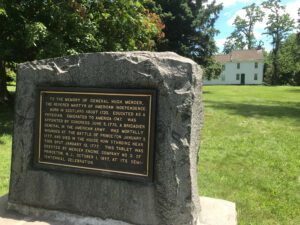 “
“ The Princeton area is also home to many other markers and monuments to the Revolutionary War, including as the site of the first of 13 markers to the battle march that Russell previously mentioned from Princeton to higher ground in Morristown. In front of Aaron Burr Hall at Nassau Street and Washington Road you can find the first, from which the troops continued north into Kingston, marked at the
The Princeton area is also home to many other markers and monuments to the Revolutionary War, including as the site of the first of 13 markers to the battle march that Russell previously mentioned from Princeton to higher ground in Morristown. In front of Aaron Burr Hall at Nassau Street and Washington Road you can find the first, from which the troops continued north into Kingston, marked at the  Mercer County is actually ranked as 11th of the top 15 counties in America with the most historic markers. If you want to find out where they all are, you can look online at sites like
Mercer County is actually ranked as 11th of the top 15 counties in America with the most historic markers. If you want to find out where they all are, you can look online at sites like  If you leave that area and continue towards what is today the former Princeton Boro municipal building, it’s hard to miss the large Princeton Battle Monument depicting Washington leading his troops that was put there in 1922. Several yards away are also several smaller markers commemorating the revolution, and people like Colonel John Haslet, a commander from Delaware that was killed at the Battle of Princeton.
If you leave that area and continue towards what is today the former Princeton Boro municipal building, it’s hard to miss the large Princeton Battle Monument depicting Washington leading his troops that was put there in 1922. Several yards away are also several smaller markers commemorating the revolution, and people like Colonel John Haslet, a commander from Delaware that was killed at the Battle of Princeton. The Revolutionary War lasted until 1783, and Princeton would continue to be a thoroughfare for passage, as a major hospital area and with many supplies manufactured nearby in Trenton. In fact, Washington’s travels back south in 1781 are commemorated with a marker placed by the Daughters of the American Revolution in 1981 as part of the Washington-Rochambeau Trail.
The Revolutionary War lasted until 1783, and Princeton would continue to be a thoroughfare for passage, as a major hospital area and with many supplies manufactured nearby in Trenton. In fact, Washington’s travels back south in 1781 are commemorated with a marker placed by the Daughters of the American Revolution in 1981 as part of the Washington-Rochambeau Trail. In Princeton, we are lucky to be able to stand in front of the home where
In Princeton, we are lucky to be able to stand in front of the home where 
 “COVID really provided us the push we needed to dive in,” shares Izzy Kasdin, Executive Director of HSP, whose organization this year compiled its virtual history-related information and activities into what it called ‘
“COVID really provided us the push we needed to dive in,” shares Izzy Kasdin, Executive Director of HSP, whose organization this year compiled its virtual history-related information and activities into what it called ‘ “As we look forward to the 250th anniversary of the signing of the Declaration of Independence in 2026, we know the eyes of the country will be looking for rich and interesting content and as a home of a signer, the only one open to the public in New Jersey, we will be ready to serve,” explains Jill Barry, Morven Museum & Garden Executive Director.
“As we look forward to the 250th anniversary of the signing of the Declaration of Independence in 2026, we know the eyes of the country will be looking for rich and interesting content and as a home of a signer, the only one open to the public in New Jersey, we will be ready to serve,” explains Jill Barry, Morven Museum & Garden Executive Director. “Historians have a special expertise, a special knowledge about our past and there are a lot of mistruths being spun about that both on the popular media and in social media, and we have a duty to step in and correct things,” said
“Historians have a special expertise, a special knowledge about our past and there are a lot of mistruths being spun about that both on the popular media and in social media, and we have a duty to step in and correct things,” said  A perfect example of this is Bernie Sanders in his mittens at the Biden inauguration in January. It became a viral meme and will forever be remembered as part of that event. Is there a detail like that you can recall from any past inauguration, and would it have become such a moment had it not been recorded and shared on social media?
A perfect example of this is Bernie Sanders in his mittens at the Biden inauguration in January. It became a viral meme and will forever be remembered as part of that event. Is there a detail like that you can recall from any past inauguration, and would it have become such a moment had it not been recorded and shared on social media?